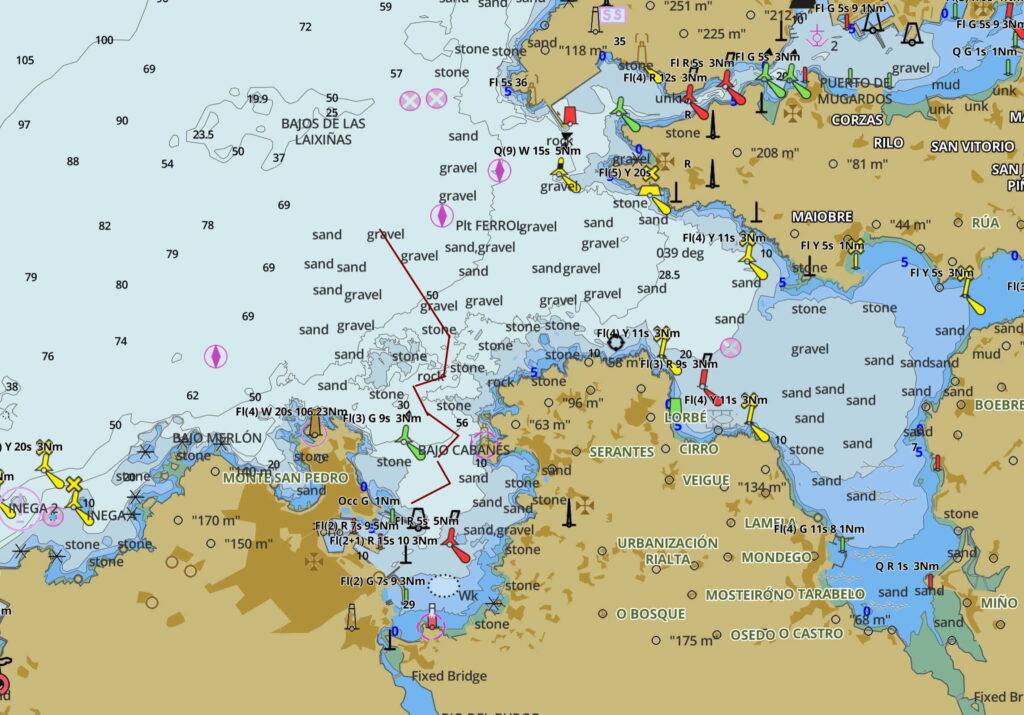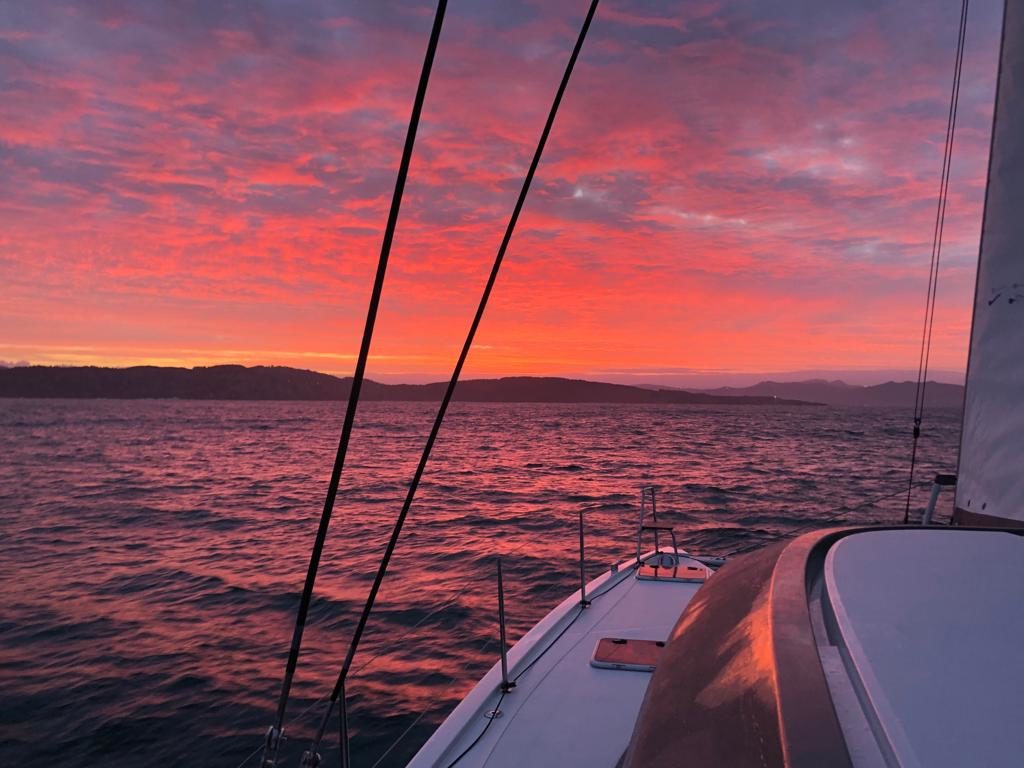Gecko Shake Down Cruise Leg 3
La Coruña to Vigo, 15 November 2019
When we had pulled into Gijon on the 13th and survived the Bay of Biscay, I remember talking to the other guys, something along the lines of: “Hmm, that was an experience, but at least it should be plain sailing from here”.
Well, that’s the last time I tempt Neptune with a line like that, because things were about to get a whole lot more serious on this next leg.
We had been eyeing a weather window while in La Coruña that would allow us to nip along the coast to Gijon- some 120 nautical miles: 17 hours of sailing at an average speed of 7 knots. Although the weather had been pretty ferocious in La Coruña since our arrival with waves smashing over the sea wall and almost sweeping a van into the sea at one point, by Friday it had started to calm down to more moderate levels.
Looking at the forecasts on PredictWind and Windy, we decided to give it a go and continue along the coast and slipped the lines at around 16.30 in a breeze and headed out into the bay from the Real Club de La Coruña.
As soon as we got into some space, and still behind the sea wall in flat water, we raised the mainsail with one reef in (forecast 15 knots of wind). We soon lowered the sail and clipped in the second reef as we were hit by gusts of up to 22 knots and had to swerve around a big tanker in the bay. I was beginning to feel more concerned about the conditions – I had originally intended to pass downwind of the tanker, but there was so much weather-helm on the boat that I ended up passing it to windward.
Once we got out into the Bay, we realised that the conditions were pretty rough. The wind was blowing 25 knots and the sea-state was pretty angry. In hindsight, we should have made the 30 minute walk around the bay from the marina to double check the waves.
With 2 reefs in, some solent tucked in, and both engines running we started punching through the waves funneling into La Coruña. There are some nasty shallows in the Bay as you head out of the city which you need to navigate through. We’d seen some pretty big waves coming in 2 days earlier, breaking over the Bajo Cabanés. The sea state and waves were worse today.

As we got out into the Bay, we realised that we were fully committed as going beam on in these kinds of waves was just not an option. With 2 reefs in and both engines going, Gecko was now smashing into 5m waves and they were still building. We threaded our way along the deeper channels avoiding the shallows, tacking NE then NW and it was at this point I figured that the skipper Pedro had a different acceptable level of risk than I did. However, he was doing a great job navigating out into deep water, and as I said earlier, we were committed, so there was no real point in debating that one.
As we tucked in between 2 areas of low water through the deeper channels, the waves built to around 8 meters and things started to feel a whole lot like a roller coaster. Gecko was powering up the steep faces helped by the freshening wind, and we were smashing down the other side, often with both bows under the water as we hit the face of the next wave -pretty scary yet exhilarating at the same time: adrenaline levels were topped out at this point.
Pedro was on the starboard helm, while I was checking the charts on the port helm. I had my phone out at one point filming the proceedings: that was an error, as a big wave swept over the coach roof and onto the port helm: end of phone.
I don’t know how long it took us to get out of the Bay, it seemed like a long time, but was probably only 20-30 minutes. Once we started to get some offing into deeper water, the wave frequency decreased and things calmed down. The deeper we got , the safer we felt and there was a communal sigh of relief as we veered WNW to avoid the Bajos de Laixiñas, another area of relatively low water and the sea state calmed from high to very rough and then rough.
However, La Coruña wasn’t done with us yet: as we headed offshore the wind started to build to 28 knots from the North. On a close to beam reach, this had us right on the limit for the second reef with 60% solent, which covers you up to 35 knots apparent wind speed. On some of the gusts, we were hitting 37- 38 knots apparent, and Gecko took off on a gallop – she felt overpowered, but it was getting dark and we were in no mood to put the 3rd reef in with these kinds of waves about, so we managed the gusts by loosening the sheets and continued west heading to the Costa de Morte or “Coast of Death”.
La Coruña Radio came up on Channel 16 at one point to check on us (translation: what the hell were you doing out in the Bay), but once we explained that the sea-state was much better offshore, they calmed down a bit and told us they’d continue to track us. Later on, we received an All Ships transmission warning everyone about the conditions around La Coruña which did nothing to calm the nerves.
The Coast of Death is Europe’s western frontier. The ancients believed this place to be Finisterrae – the end of the world – the gate to the afterlife. Hmmm. That was where we were now heading. We had a run west with the wind on the beam and the worry of the increasing apparent wind until we cleared Isla Sisarga, at which point we’d be able to bear away south and hopefully get the apparent wind speed down.
The watch system went out of the window on this leg as we rounded the top of the Iberian Peninsular and sailed south in a Force 6 past Cape Finisterre and along the Costa de la Muerte. The oceanic floor rises up very quickly along this coast going from 1500-2000m to 2-300m in a short distance which can create some nasty waves, particularly if the weather is coming in from the west. We had northerlies, which reduced the risk, but even so, we were glued to the chart and stayed well clear of any aggressive looking gradient changes and patches of lower water.
As we turned south, the wind calmed to a Force 5 and we rode a following sea south along the coast. Surfing down the waves, we were hitting speeds in the mid teens and making great progress. Just before daybreak, we spotted the leading lights for the channel into Vigo and threaded our way past the Isla do Norte towards Vigo, and as the sun came up, the weather calmed further giving us a lovely 2 hour run into the Galician City past the beaches and fishing communities in the bay. What a stunning setting- it reminded me of the landscape around Sai Kung County Park in Hong Kong- that’ll be all the granite I guess.

At 10.30 on the 16th November, we arrived safe and sound at the Real Club Nautico de Vigo – a lovely little marina in the center of the city with a few other catamarans including another Nautitech Open 40.
Time for a hot shower a chat to reflect on the last 24 hours.
Video by Pedro (from the Catamaran Center) who skippered this leg. I must have been in my bunk at this point.
Translation from Spanish: “Well, after a pretty hard passage, the wind has died, the sea is calmer and we are coming into the Bay of Vigo. We´re passing these islands to starboard. Here´s my mate Jim. To all of you, the passage for Catamaran Center from La Rochelle to Port Ginesta. See you soon”
